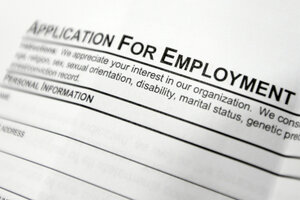Why is the Fed hesitant to raise interest rates, despite low unemployment?
In the 1990s, an unemployment rate below 6 percent would be a sure sign of rising interest rates. Today, the calculus has changed.

An employment application form on a table during a job fair at Columbia-Greene Community College in Hudson, N.Y., in 2014.
Mike Groll/AP/File
Despite a falling unemployment rate in the United States that landed at 4.9 percent last month, the Federal Reserve is expected to leave interest rates undisturbed again this week.
The central bank had been expected to raise rates as many as four times in 2016 to stave off inflation as the economy continues its long recuperation. But the Fed has deferred repeatedly for fear a rate hike could erode economic progress to date.
“Mistiming a rate increase has consequences,” Kevin Granville and Binyamin Appelbaum wrote for The New York Times on Sunday. “If the Fed moves too soon, it could derail what remains a relatively weak economic expansion. If it waits too long, it could be forced to hit the brakes even harder.”
Conventional wisdom in the 1990s held that the Fed should consider raising rates if unemployment fell below 6 percent. That was believed at the time to be the the threshold of “full employment,” according to Dean Baker, co-director of the Center for Economic and Policy Research in Washington, D.C.. Officials said unemployment figures below that threshold could send the inflation rate spiraling upward. As labor markets tighten, wages rise and tend to push prices up too.
“That proved to be wrong,” Dr. Baker tells The Christian Science Monitor, pointing to the peaceful coexistence of low unemployment rates and relatively stable inflation at the turn of the century.
Baker co-authored the 2013 book “Getting Back to Full Employment” with Dr. Jared Bernstein, a senior fellow with the Center on Budget and Policy Priorities in Washington. The two argued that 4-percent unemployment, which was the average rate in 2000, constitutes a target worth aiming for.
Digging below the surface of the jobless rate reported each month by the Bureau of Labor Statistics, however, reveals a more complicated story.
“I think right now the unemployment rate is not giving us the same information about labor market tightness as it did two decades ago,” Baker says. The figure fails to account for Americans who have given up looking for work or those who are under-employed.
From a postwar peak of 98 percent, the share of men aged 25 to 54 in the workforce has fallen to 88 percent, as The Christian Science Monitor has reported.
“It’s not something you would expect in a strong labor market,” Baker adds, noting he would be surprised if the Fed takes action this week, especially since inflation remains comfortably below the Fed's 2-percent target average, despite a recent bump in consumer prices.
Fed chair Janet Yellen has cited persistently low oil prices and a strong dollar as temporary restraints on inflation.
Still, others are ready for higher interest rates. “Let’s get on with it already,” Michael Arone, chief investment strategist at State Street Global Advisors, told Reuters on Monday. “It will cause some challenges to the market, but I think that is healthy in context of a normal business cycle.”
Mr. Arone said a hike would raise the cost of capital and “flush out some riskier assets in the short term” is “probably the right thing to do.”
Quincy Krosby, a market strategist at Prudential Financial, told CNBC that she expects the Feds to hold off again on raising rates, “but it will be a more hawkish hold,” meaning the governors could signal a future hike, perhaps in December.
Material from Reuters was used in this report.

